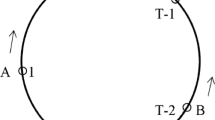Abstract
In disaster scenarios, with damaged network infrastructure, cognitive radio (CR) can be used to provide temporary network access in the first few hours. Since spectrum occupancy will be unknown, the radios must rely on spectrum sensing and opportunistic access. An initial goal is to establish rendezvous between CR nodes to set up the network. The unknown primary radio (PR) activity and CR node topology makes this a challenging task. Existing blind rendezvous strategies provide guarantees on time to rendezvous, but assume channels with no PR activity and no external interferers. To handle this problem of blind multi-node rendezvous in the presence of primary users, we propose an Extended Modular Clock Algorithm which abandons the guarantee on time to rendezvous, an information exchange mechanism for the multi-node problem, and various cognitive radio operating policies. We show that the adapted protocols can achieve up to 80% improvement in the expected time to rendezvous and reduce the harmful interference caused to the primary radio.
Access this chapter
Tax calculation will be finalised at checkout
Purchases are for personal use only
Similar content being viewed by others
References
Ghafoor, S., Sutton, P.D., Sreenan, C.J., Brown, K.N.: Cognitive radio for disaster response networks: survey, potential, and challenges. IEEE Wirel. Commun. 21(5), 70–80 (2014)
Theis, N.C., Thomas, R.W., DaSilva, L.A.: Rendezvous for cognitive radios. IEEE Trans. Mob. Comput. 10(2), 216–227 (2011)
Liu, H., Lin, Z., Chu, X., Leung, Y.W.: Jump-stay rendezvous algorithm for CRNs. IEEE Tran. Parallel Distrib. Syst. 23(10), 1867–1881 (2012)
Lin, Z., Liu, H., Chu, X., Leung, Y.W.: Enhanced jump-stay rendezvous algorithm for cognitive radio networks. IEEE Commun. Lett. 17(9), 1742–1745 (2013)
Zhang, Y., Yu, G., Li, Q., Wang, H., Zhu, X., Wang, B.: Channel-hopping-based communication rendezvous in CRNs. IEEE Trans. Netw. 22(3), 889–902 (2014)
Chao, C.M., Fu, H.Y., Zhang, L.R.: A fast rendezvous-guarantee channel hopping protocol for CRNs. IEEE Trans. Veh. Technol. 64(12), 5804–5816 (2015)
Pu, H., Gu, Z., Lin, X., Hua, Q.S., Jin, H.: Dynamic rendezvous algorithms for cognitive radio networks. In: IEEE International Conference on Communications (ICC), pp. 1–6 (2016)
Robertson, A., Tran, L., Molnar, J., Fu, E.H.F.: Experimental comparison of blind rendezvous algorithms for tactical networks. In: IEEE WoWMoM, pp. 1–6 (2012)
IEEE 802.22.2: Part 22.2: Installation and Deployment of CR Systems (2012)
Sutton, P.D., Nolan, K.E., Doyle, L.E.: Cyclostationary signatures in practical cognitive radio applications. J. Sel. Areas Commun. 26(1), 13–24 (2008)
Saleem, Y., Rehmani, M.H.: Primary radio user activity models for cognitive radio networks - a survey. J. Netw. Comput. Appl. 43, 1–16 (2014)
Saleem, Y., Yau, K.A., Mohamad, H., Ramli, N., Rehmani, M.H.: SMART- a SpectruM-Aware clusteR-based rouTing scheme for distributed cognitive radio networks. Elsevier Comput. Netw. 91, 196–224 (2015)
Kim, H., Shin, K.: Efficient discovery of spectrum opportunities with MAC-layer sensing in cognitive radio networks. IEEE Trans. Mob. Comput. 7(5), 533–545 (2008)
Kim, H., Shin, K.: Fast discovery of spectrum opportunities in cognitive radio networks. In: IEEE DySPAN 2008 (2008)
Min, A.W., Shin, K.G.: Exploiting multi-channel diversity in spectrum-agile network. In: Proceedings of the INFOCOM (2008)
http://faculty.uml.edu/Tricia_Chigan/Research/CRCN_Simulator.htm
Acknowledgement
This publication has emanated from research conducted with the financial support of Science Foundation Ireland (SFI) under the CTVR (SFI 10/CE/I1853), CONNECT (13/RC/2077) and INSIGHT (SFI/12/RC/2289) grants.
Author information
Authors and Affiliations
Corresponding author
Editor information
Editors and Affiliations
Rights and permissions
Copyright information
© 2018 ICST Institute for Computer Sciences, Social Informatics and Telecommunications Engineering
About this paper
Cite this paper
Ghafoor, S., Sreenan, C.J., Brown, K.N. (2018). Cognitive Radio Policy-Based Adaptive Blind Rendezvous Protocols for Disaster Response. In: Marques, P., Radwan, A., Mumtaz, S., Noguet, D., Rodriguez, J., Gundlach, M. (eds) Cognitive Radio Oriented Wireless Networks. CrownCom 2017. Lecture Notes of the Institute for Computer Sciences, Social Informatics and Telecommunications Engineering, vol 228. Springer, Cham. https://doi.org/10.1007/978-3-319-76207-4_8
Download citation
DOI: https://doi.org/10.1007/978-3-319-76207-4_8
Published:
Publisher Name: Springer, Cham
Print ISBN: 978-3-319-76206-7
Online ISBN: 978-3-319-76207-4
eBook Packages: Computer ScienceComputer Science (R0)




